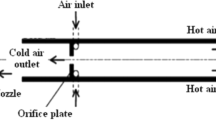Abstract
A vortex tube with additional chamber is investigated by computational fluid mechanics techniques to realize the effects of additional chamber in Ranque–Hilsch vortex tube and to understand optimal length for placing the second chamber in order to have maximum cooling effect. Results show that by increasing the distance between two chambers, both minimum cold and maximum hot temperatures increase and maximum cooling effect occurs at Z/L = 0.047 (dimensionless distance).















Similar content being viewed by others
Abbreviations
- D:
-
Diameter of vortex tube (mm)
- k:
-
Turbulence kinetic energy (m2/s2)
- L:
-
Length of vortex tube (mm)
- r:
-
Radial distance measured from centerline of tube (mm)
- R:
-
Radius of vortex tube (mm)
- T:
-
Temperature (K)
- Z:
-
Axial length from nozzle cross section (mm)
- COP:
-
Coefficient of performance
- RHVT:
-
Ranque–Hilsch vortex tube
- ΔT i,c :
-
Temperature difference between inlet and cold end (K)
- ΔT i,h :
-
Temperature difference between inlet and hot end (K)
- \(\dot{m}_{in}\) :
-
Inlet mass flow rate (kg/s)
- \(\dot{m}_{c}\) :
-
Cold mass flow rate (kg/s)
- \(\dot{m}_{h}\) :
-
Hot mass flow rate (kg/s)
- α:
-
Cold mass fraction
- ε:
-
Turbulence dissipation rate (m2/s3)
- ρ:
-
Density (kg/m3)
- μ:
-
Dynamic viscosity [kg/(m s)]
- μt :
-
Turbulent viscosity [kg/(m s)]
- τij :
-
Stress tensor components
- re:
-
Refrigerator
References
Ranque GJ (1933) Experiments on expansion in a vortex with simultaneous exhaust of hot air and cold air. J Phys Radium (Paris) 4:112–114 S-115, June. Also translated as General Electric Co., Schenectady Works Library (1947); T.F. 3294
Ranque GJ (1934) Method and apparatus for obtaining from a fluid under pressure two outputs of fluid at different temperatures. US Patent 1:952,281
Hilsch R (1947) The use of the expansion of gases in a centrifugal field as cooling process. Rev Sci Instrum 18(2):108–113
Stephan K, Lin S, Durst M, Huang F, Seher D (1983) An investigation of energy separation in a vortex tube. Int J Heat Mass Transf 26(3):341–348
Ahlborn BK, Gordon JM (2000) The vortex tube as a classic thermodynamic refrigeration cycle. J Appl Phys 88(6):3645–3653
Saidi MH, Valipour MS (2003) Experimental modeling of vortex tube refrigerator. Appl Therm Eng 23:1971–1980
Aljuwayhel NF, Nellis GF, Klein SA (2005) Parametric and internal study of the vortex tube using a CFD model. Int J Refrig 28:442–450
Skye HM, Nellis GF, Klein SA (2006) Comparison of CFD analysis to empirical data in a commercial vortex tube. Int J Refrig 29:71–80
Akhesmeh S, Pourmahmoud N, Sedgi H (2008) Numerical study of the temperature separation in the Ranque–Hilsch vortex tube. Am J Eng Appl Sci 3:181–187
Behera U, Paul PJ, Kasthurirengen S, Karunanithi R, Ram SN, Dinesh K, Jacob S (2005) CFD analysis and experimental investigations towards optimizing the parameters of Ranque–Hilsch vortex tube. Int J Heat Mass Transf 48:1961–1973
Dincer K, Tasdemir S, Baskaya S, Uysal BZ (2008) Modeling of the effects of length to diameter ratio and nozzle number on the performance of counter flow Ranque–Hilsch vortex tubes using artificial neural networks. Appl Therm Eng 28:2380–2390
Bramo AR, Pourmahmoud N (2010) A numerical study on the effect of length to diameter ratio and stagnation point on the performance of counter flow vortex tube. Aust J Basic Appl Sci 4:4943–4957
Bramo AR, Pourmahmoud N (2011) CFD simulation of length to diameter ratio effect on the energy separation in a vortex tube. Therm Sci 15(3):833–848
Shamsoddini R, Nezhad AH (2010) Numerical analysis of the effects of nozzles number on the flow and power of cooling of a vortex tube. Int J Refrig 33:774–782
Khazaei H, Teymourtash AR, Malek-Jafaria M (2012) Effects of gas properties and geometrical parameters on performance of a vortex tube. Scientia Iranica B 19(3):454–462
Shamsoddini R, Faghih Khorasani A (2012) A new approach to study and optimize cooling performance of a Ranque–Hilsch vortex tube. Int J Refrig 35(8):2339–2348
Shannak BA (2004) Temperature separation and friction losses in vortex tube. Heat Mass Transf 40:779–785
Hamdan MO, Alawar A, Elnajjar E, Siddique W (2011) Experimental analysis on vortex tube energy separation performance. Heat Mass Transf 47:1637–1642
Dincer K, Baskaya S, Uysal BZ (2008) Experimental investigation of the effects of length to diameter ratio and nozzle number on the performance of counter flow Ranque–Hilsch vortex tubes. Heat Mass Transf 44:367–373
Pourmahmoud N, Hassan Zadeh A, Moutaby O (2012) Numerical analysis of the effect of helical nozzles gap on the cooling capacity of Ranque–Hilsch vortex trube. Int J Refrig 35:1473–1483
Author information
Authors and Affiliations
Corresponding author
Rights and permissions
About this article
Cite this article
Pourmahmoud, N., Azar, F.S. & Hassanzadeh, A. Numerical simulation of secondary vortex chamber effect on the cooling capacity enhancement of vortex tube. Heat Mass Transfer 50, 1225–1236 (2014). https://doi.org/10.1007/s00231-014-1335-z
Received:
Accepted:
Published:
Issue Date:
DOI: https://doi.org/10.1007/s00231-014-1335-z




